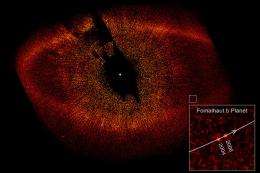Water-Ice Super-Earths

A "super-Earth" is a planet around another star (an "exoplanet") whose mass is less than about ten times that of the Earth. Of the 480 or so extrasolar planets now known, most have masses larger than the mass of Jupiter, which is 318 times more massive than the Earth. About two dozen, though, appear to have masses that put them into the super-Earth category. About 70 exoplanets have orbits that happen to be aligned such that the planet passes directly between the star and the Earth (a transit).
This coincidence allows astronomers to determine the exoplanet’s radius, and then, knowing the mass, one of the most interesting of all its characteristics: its density. The density reveals whether the planet is primarily rocky, gaseous, or perhaps contains water. Liquid water is, of course, a key ingredient since water is required for an exoplanet to be Earth-like as well as Earth-sized.
Robert Marcus, Dimitar Sasselov, and Lars Hernquist, three CfA astronomers, together with a colleague, have completed a theoretical study of water-bearing super-Earths (or, if they are cold, ice-bearing super-Earths), basing their models in part on the characteristics of two known water/icy super-Earths and the larger icy bodies in the outer solar system.
Planets form gradually when smaller bodies in a stellar disk collide and stick together, and current models seem to be successful in describing the probability distribution of planets ending up as rocky, water/ice, or otherwise; 75% water/ice is the commonly assumed maximum value. When more mature larger bodies collide, though, they can fragment into smaller bodies as well as produce an even larger planet with some characteristics of both.
The CfA scientists wondered whether collisions between water/icy super-Earths could change this distribution and increase the amount of water on a planet, perhaps even to levels above 75%.
The astronomers started with super-Earths that were made of 50% water/ice and 50% serpentine rock (which itself contains another 15% water). They gave the colliding planets mass ratios of between 1:1 and 4:1, and considered a range of impact types, from head-on to glancing. They found that these giant impacts could not increase the fraction of water/ice above 50%. Either the rocky material also accreted at the same proportion as the water, or else the collision actually stripped water away from the planet.
The new results are important because they provide an upper limit to the amount of water/ice (75%) that astronomers can use in modeling any newly discovered exoplanet, and give added credibility to the new field of exoplanet morphology.
Provided by Harvard-Smithsonian Center for Astrophysics




















